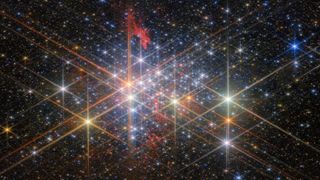
Why do we have star production zones if consciousness is uninvolved? Is it the nature of 3D life to produce a fresh mass of stars? Just Saying.
Now please show me how to do any of this otherwise.
So many pretend to know what is obviously unknowable.
Space photo of the week: James Webb telescope spots the ultimate 'super star cluster' deep in the Milky Way
By Jamie Carter
So many pretend to know what is obviously unknowable.
Space photo of the week: James Webb telescope spots the ultimate 'super star cluster' deep in the Milky Way
By Jamie Carter
published 16 hours ago
Once blocked from view, the most massive young star cluster in the Milky Way has finally been revealed by the James Webb Space Telescope.
JWST's view of Westerlund 1, one of the closest "super star" clusters to the solar system. (Image credit: ESA/Webb, NASA & CSA, M.Zamani (ESA/Webb), M. G. Guarcello (INAF-OAPA) and the EWOCS team)
What it is: super star cluster Westerlund 1
Once blocked from view, the most massive young star cluster in the Milky Way has finally been revealed by the James Webb Space Telescope.
JWST's view of Westerlund 1, one of the closest "super star" clusters to the solar system. (Image credit: ESA/Webb, NASA & CSA, M.Zamani (ESA/Webb), M. G. Guarcello (INAF-OAPA) and the EWOCS team)
What it is: super star cluster Westerlund 1
No comments:
Post a Comment